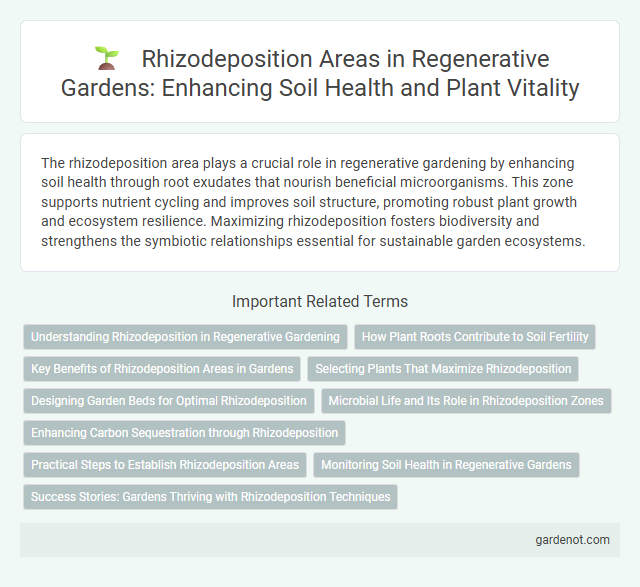The rhizodeposition area plays a crucial role in regenerative gardening by enhancing soil health through root exudates that nourish beneficial microorganisms. This zone supports nutrient cycling and improves soil structure, promoting robust plant growth and ecosystem resilience. Maximizing rhizodeposition fosters biodiversity and strengthens the symbiotic relationships essential for sustainable garden ecosystems.
Understanding Rhizodeposition in Regenerative Gardening
Rhizodeposition refers to the release of organic compounds from plant roots into the surrounding soil, enriching microbial communities and enhancing soil fertility in regenerative gardening systems. This process drives nutrient cycling and supports beneficial symbiotic relationships, crucial for improving soil structure and plant health without chemical inputs. Understanding rhizodeposition helps optimize root-zone interactions, promoting sustainable ecosystem functions and resilient crop production.
How Plant Roots Contribute to Soil Fertility
Plant roots enhance soil fertility through rhizodeposition, releasing organic compounds such as sugars, amino acids, and mucilage into the rhizosphere. These exudates stimulate microbial activity and nutrient cycling, improving soil structure and increasing the availability of essential nutrients like nitrogen and phosphorus. The continuous input of root-derived carbon supports diverse microbial communities, which play a crucial role in decomposing organic matter and promoting plant growth in regenerative gardens.
Key Benefits of Rhizodeposition Areas in Gardens
Rhizodeposition areas in regenerative gardens enhance soil fertility by promoting the release of organic compounds from plant roots, which support beneficial microbial communities and nutrient cycling. These zones improve soil structure and water retention, leading to healthier plant growth and greater resilience against drought. By fostering a dynamic root-soil interface, rhizodeposition areas contribute to carbon sequestration and long-term ecosystem sustainability.
Selecting Plants That Maximize Rhizodeposition
Selecting plants with extensive root systems such as legumes, grasses, and deep-rooted perennials enhances rhizodeposition by increasing root exudates that support soil microbial activity and nutrient cycling. Species like clover and alfalfa are particularly effective due to their symbiotic nitrogen-fixing capabilities, which enrich soil organic matter through rhizodeposition. Maximizing root biomass and diversity optimizes carbon input into the soil, fostering a healthier regenerative garden ecosystem.
Designing Garden Beds for Optimal Rhizodeposition
Designing garden beds for optimal rhizodeposition involves selecting plant species with extensive root systems that enhance carbon and nutrient release into the soil. Incorporating deep-rooted perennials and diverse polycultures maximizes root exudates, fostering microbial activity and improving soil structure. Strategically spacing plants to prevent root crowding ensures effective nutrient cycling and promotes sustainable soil regeneration.
Microbial Life and Its Role in Rhizodeposition Zones
Rhizodeposition zones host diverse microbial communities crucial for nutrient cycling and soil health in regenerative gardens. Microbial life in these areas decomposes root exudates, releasing essential nutrients that enhance plant growth and soil fertility. This symbiotic relationship supports carbon sequestration and promotes resilient ecosystem functions by maintaining soil structure and microbial diversity.
Enhancing Carbon Sequestration through Rhizodeposition
Rhizodeposition significantly enhances carbon sequestration by releasing organic compounds, such as root exudates, into the soil, which stimulate microbial activity and promote soil aggregation. This biological process increases soil organic carbon stocks by facilitating the formation of stable soil carbon pools within the rhizosphere. Optimizing rhizodeposition through regenerative gardening practices improves soil fertility and mitigates atmospheric CO2 levels, contributing to sustainable carbon management.
Practical Steps to Establish Rhizodeposition Areas
Establishing rhizodeposition areas begins with selecting diverse, deep-rooted plant species that promote extensive root exudation to enhance microbial activity and nutrient cycling. Incorporate organic mulches and minimal soil disturbance to maintain soil structure and support microbial communities critical for rhizodeposition processes. Regular monitoring of soil health indicators such as microbial biomass and enzyme activity ensures the effectiveness and sustainability of rhizodeposition zones in regenerative garden systems.
Monitoring Soil Health in Regenerative Gardens
Rhizodeposition, the process where plant roots release organic compounds into the soil, plays a crucial role in enhancing soil microbial activity and nutrient cycling in regenerative gardens. Monitoring soil health in the rhizodeposition zone involves assessing microbial biomass, soil respiration rates, and nutrient availability to ensure optimal conditions for plant growth and carbon sequestration. Regular sampling and analysis using soil sensors and laboratory tests provide valuable insights into maintaining soil fertility and improving ecosystem resilience.
Success Stories: Gardens Thriving with Rhizodeposition Techniques
Rhizodeposition areas significantly boost soil health by increasing microbial activity and nutrient availability, resulting in vibrant, resilient gardens. Successful regenerative gardens utilizing rhizodeposition techniques report enhanced plant growth, increased biodiversity, and improved soil structure. Case studies from permaculture farms demonstrate up to 30% higher crop yields and stronger disease resistance linked to effective rhizodeposition management.
Rhizodeposition area Infographic

 gardenot.com
gardenot.com